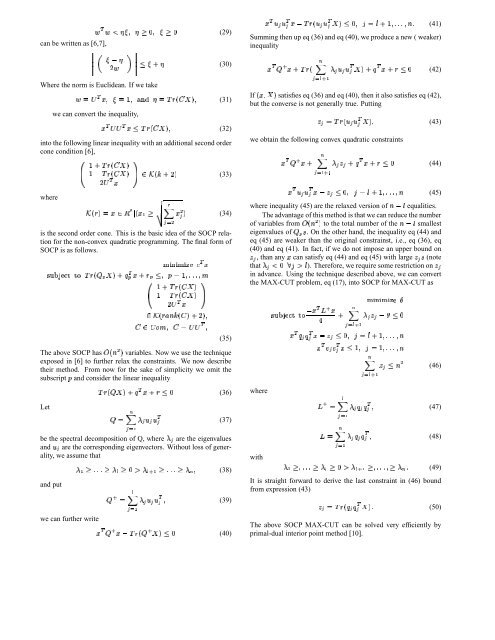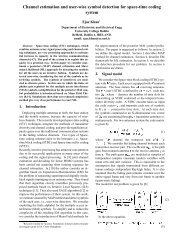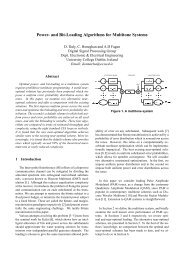¢¢''V¨§¢R¨HWRV¢+6 N A ¨§ +AAV'AV"V : ; 0 ; CMR6RMcan be written as [6,7],9A9¡ @B+@ + B# (29)2c;.2Summing then up eq (36) and eq (40), we produce a new ( weaker)inequality A; C R¡2; 2; W + =/'"1 + ¨3 +4£ (41)¢¢¢C B@9 W ¢Where the norm is Euclidean. If we take¢¢¢B "@ (30)' A + B' 1 + M ¢¤£ @¢' R¡ +(31)9we can convert the inequality,into the following linear inequality with an additional <strong>second</strong> <strong>order</strong>cone condition [6], A A W R¡ +(32)(33)A(' R¡V ": ;.2c; 2 ;; " ) A " AW (42)+ satisfies eq (36) and eq (40), then it also satisfies eq (42),If¡but the converse is not generally true. Putting0 ; ' R¡2c;.2; + A(43)we obtain the following convex quadratic constraints A ' " : ; 0 ;"*) A "W (44)where" R 1 C R¡ ¥¦1A ©¡R ' /.7¡ L: ¢+; (34) ;is the <strong>second</strong> <strong>order</strong> cone. This is the basic idea <strong>of</strong> the SOCP relationfor the non-convex quadratic programming. The final form <strong>of</strong>SOCP is as follows.; A2 ; C0 ; + = '"1 + 33 +4£(45)W2;where inequality (45) are the <strong>of</strong>£ C relaxed version equalities.The advantage <strong>of</strong> this method is that we can reduce the number<strong>of</strong>¢¡¤£ + variables from to the total the£ C number smallesteigenvalues H $ <strong>of</strong> . On the other hand, the inequality eq (44) andeq (45) are weaker than the original constrainst, i.e., eq (36), eq(40) and eq (41). In fact, if we do not impose an upper bound ';on, than any can satisfy eq (44) and eq (45) with large 0 ; $ (note 0©¡ 7 "013254¦678/8¥9 ¡ 'H% " ) AH "RK¡ %¢& K¡ %$+ +' 1 + 33 + 8that ; O= ). Therefore, we require some restriction on 0 ;in advance. Using the technique described above, we can convertthe MAX-CUT problem, eq (17), into SOCP for MAX-CUT asK¡ £¢ K¡ £$¥¦1" R¡ 1 C R¡ A ©¡RF£87 ¡ "C A 013254¦678=8¥9(35)P8 + ' A + The above SOCP¢¡¤£ + has variables. Now we use the techniqueexposed in [6] to further relax the constraints. We now describetheir method. From now for the sake <strong>of</strong> simplicity we omit thesubscript and consider the linear inequality+Let R¡ ' " ) A "W (36);A(37)where A );) A; W C0 ;W + =/'"1 + "3 +4£ A;; AW1 + = ' 1 + "3 +4£ ; V ; '; V :0 ;W£ +(46););) A; +(47):;.2c; 2:be the spectral decomposition <strong>of</strong> Q, where ; are the eigenvalues2c; and are the corresponding eigenvectors. Without loss <strong>of</strong> generality,we assume thatand put: 33we can further write' ¤; V ; '¤ : : ; 2 ; 2 A ' C R¡ ' 33+(38); + A(39)W (40)with: + ¨3 ;;);) A; +(48): It is straight forward to derive the last constraint in (46) boundfrom expression (43) : + "¨+ (49)0 ; ' R¡ );) A; (50)The above SOCP MAX-CUT can be solved very efficiently byprimal-dual interior point method [10].
6. CONCLUSIONSIn this paper, we proposed a new ML <strong>detection</strong> method for the<strong>MIMO</strong> channel. This method is based on relaxing the MAX-CUT problem and solving the resulting <strong>system</strong> by SOCP. We haveshown that the MAX-CUT (equivalently ML <strong>detection</strong>) problemcan be formulated into SOCP problem. The advantage <strong>of</strong> the proposedmethod over the SDP relaxation is that the difference in thenumber <strong>of</strong> variables between SDP relaxation and SOCPas£increasesbecomes large. Hence MAX-CUT SOCP is numerically moreefficient. Although, in general, the lower bound computed bySOCP relaxation is not as good as a bound obtained with SDPrelaxation in theory, they are <strong>of</strong>ten close to each other [6]. Theproposed method has three significant advantages over the spheredecoding technique.1) The proposed method is polynomial time irrespective <strong>of</strong> thevalue <strong>of</strong> the SNR as opposed to sphere decoding which has exponentialcomplexity for low SNR values.2) The SOCP has no heuristic parameters to set (unlike the spheredecoder in which the optimal radius has to be selected in a heuristicway).3) The sphere decoder complexity,¢¡¤£ ¥ , is at each time instant,while there is no such problem in SOCP approach.Moreover our approach does not require number <strong>of</strong> the receive antennasto be greater than number <strong>of</strong> the transmit antennas as theBLAST receiver does. Simulations results in figure 2 shows thatSOCP gives very close approximation to the exact ML and thatthere is almost no difference between the performance <strong>of</strong> the SDPand SOCP method. Simulations are performed for two transmitand two receive antennas. In general for large£the saving <strong>of</strong> CPUtime gets larger for SOCP in comparison to SDP method.[2] G.J. Foschini, ”Layered space-time architecture for wirelesscommunication in a fading environment when <strong>using</strong> multielementantenna ”, Bell labs Tech. Journal, vol.1, no.2, pp.41-59, 1996.[3] H. Vikalo and B. Hassibi, ”<strong>Maximum</strong> <strong>likelihood</strong> sequence <strong>detection</strong>for multiple antenna <strong>system</strong> over dispersive channelsvia sphere decoding ”, Eurasip Journal on App. Signal Processing, no.5, pp.525-531, May, 2002.[4] M.X. Goemans and D.P. Williamson, ”Improved approximationalgorithms for maximum cut and satisfiability problems<strong>using</strong> semidefinite programming ” Int. Journal <strong>of</strong> ACM, no.42,pp.1115-1145, 1995.[5] B. Mohar and S. Poljak, ”Eigenvalues and max-cut problem”Czechoslavak mathematical journal, no.40, pp.343-352, 1990.[6] S. Kim and M. Kojima, ”Second <strong>order</strong> cone programming relaxation<strong>of</strong> non-convex quadratic optimization problems” Optimizationmethods and s<strong>of</strong>tware no.15, pp.201-224, 2001.[7] M.S. Lobo, L. Vandenberghe, S. Boyd and H. Lebret, ”Applications<strong>of</strong> <strong>second</strong> <strong>order</strong> cone programming, Tech. report January31, 1998.[8] C. Helmberg and F. Rendl , ”Solving quadratic (0,1) problemsby semidefinite programs and cutting planes”, Mathematicalprogramming, vol.82, pp. 219-315, 1998.[9] M. Junger and G. Rinaldi, ”Relaxation <strong>of</strong> Max-Cut problemand computations <strong>of</strong> spin glass ground states”, Tech. reportno. 97.300, 1997.[10] Y. E. Nesterov and A. S. Nemirovskii, ”Interior point polynomialalgorithms in convex programming”, SIAM studies inApplied Mathematics, SIAM, Philadelphia, PA, 1994. .10 0BER versus SNRexact MLSDP MLSOCP ML10 −1BER10 −210 −310 −40 0.5 1 1.5 2 2.5 3 3.5 4 4.5 5SNR in dBFig. 2. Av. BER for N=2, M=2 vs ¢¡¤£¦¥¨§©¦ .7. REFERENCES[1] I.E. Talatar, ”Capacity <strong>of</strong> multi-antenna Gaussian channels ”,European Trans. on Telecommunications, vol.6,no., pp.585-595, no.11, 1999.




